Making furniture means that you need to have a firm understanding of what type of hardwood to use. Selecting the wrong species may mean that your project does not turn out exactly how you envisioned it. Before you decide to go browse around your local lumberyard, there are a few things you should know about purchasing exotic wood species. How much do you know about the popular sheesham wood?
Sheesham wood is quickly becoming a favorite among furniture-makers. It is a hardwood option that is still pliable and ready to be made into fine woodworking projects. You will find that this wood is easy to work with and beautiful to behold, but you can see the benefits of choosing it for yourself with this short guide.
What is Sheesham Wood?
The Dalbergia Sissoo tree is responsible for producing the popular sheesham wood that is commonly used in woodworking projects. Some people refer to this tree only as the sheesham tree, but others may know it as the tree that produces Indian rosewood. In other parts of the world, this tree is given many different affectionate nicknames, including the Himalaya Raintree, the Indian Dalbergia, and even the penny leaf tree.
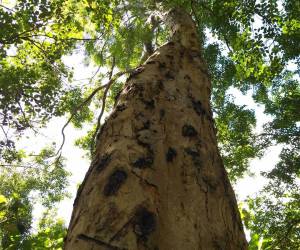 This deciduous tree is native to the Indian subcontinent and can be found in areas including Punjab, West Bengal, and Assam. The sub-Himalayan regions are home to the vast majority of these trees. However, you can also find it in other parts of the world, including Africa, Australia, and even parts of the United States.
This deciduous tree is native to the Indian subcontinent and can be found in areas including Punjab, West Bengal, and Assam. The sub-Himalayan regions are home to the vast majority of these trees. However, you can also find it in other parts of the world, including Africa, Australia, and even parts of the United States.
When found in nature, this tree can produce beautiful pink and white flowers that are closely related to pea flowers. It also produces a sort of dry fruit that comes with its own pale brown pod. The tree and its fruit are sometimes used to treat skin disorders and gastrointestinal upset in native lands. Despite these offerings, the most significant thing that the sheesham tree has to offer the world is its lumber.
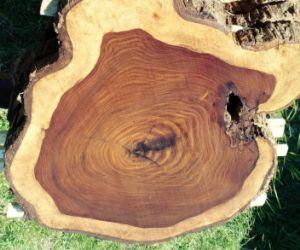 Learning how to identify sheesham wood is relatively simple. If you have ever taken a look at this lustrous wood, you would be hard-pressed to find anything else that looks relatively similar. Sheesham wood ranges in color from a light golden brown to a deeper reddish hue.
Learning how to identify sheesham wood is relatively simple. If you have ever taken a look at this lustrous wood, you would be hard-pressed to find anything else that looks relatively similar. Sheesham wood ranges in color from a light golden brown to a deeper reddish hue.
These two colors can swirl together, even on just one piece of wood. In addition to the stunning variation in color found throughout the wood, you will also encounter dark streaks that add to the contrast.
Keep in mind that some of this beautiful coloring will not stay. You may start to see it develop a darker color with age and UV exposure, just like you would with other types of rosewood products.
The grain of the wood is dense and straight, with some pieces featuring interlocked grain. It has similar grain patterns to other exotic species like teak and mango wood.
What Can I Use Sheesham For?
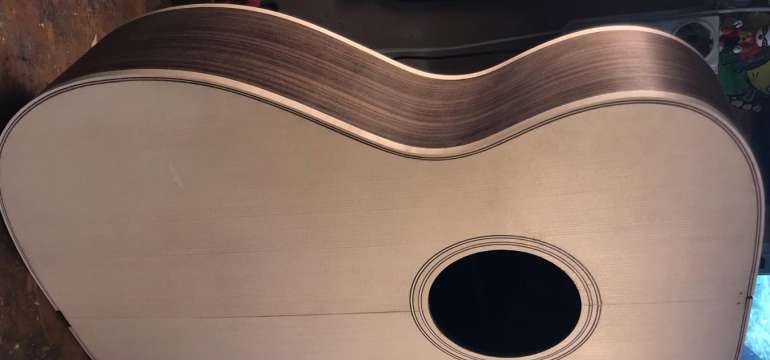
Many woodworkers have been drawn in by the beauty of sheesham wood, but they aren’t sure exactly how to incorporate it into their projects. The good news is that it is easier than ever to use sheesham for your next project. The durability of this hardwood species makes it ideal for building musical instruments, furniture, cabinets, desks, and so much more.
While sheesham is technically classified as a hardwood, most woodworkers will tell you that it is pliable. Once the wood has been dried and transformed into lumber, the boards tend to be resilient and have a great deal of flexibility. This is one of the many advantages of selecting sheesham wood.
If you want to know how well a particular piece of wood will stand up to wear and tear, it is important to look at the Janka rating. This is a standardized test administered to different wood species so that it is easy to compare their hardness and density. During the test, researchers determine how much force is required to impress a small steel ball halfway into the wood.
The Janka rating for sheesham is right about 1,600 to 1,700. This is a relatively high score when you consider that common hardwood species like red oak and maple range from 1,200 to 1,400. Sheesham gives carpenters a harder option than some of these common woods, but it is still softer than many of the more exotic species like Brazilian teak.
Sheesham Wood vs. Mango Wood
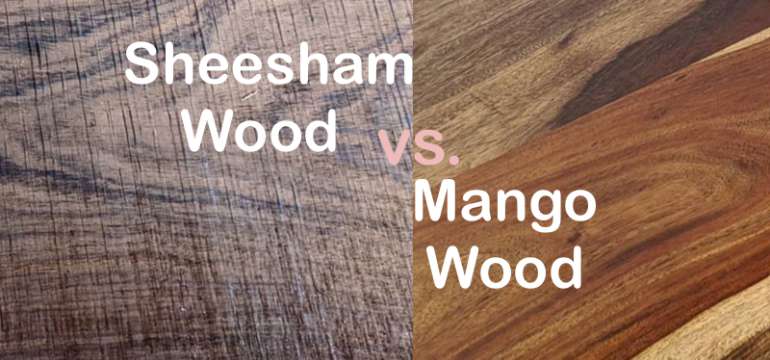
If you want to make furniture, many people will want to compare the ever-popular mango wood with sheesham. These two species have many of the same pros and cons, so it can be challenging to make a final decision. However, there are some clear advantages to choosing one type of wood over the other.
First and foremost, mango wood is going to be the softer choice. You may think this makes it the less desirable option, but that really depends on what you are hoping to build. It is still a very strong wood that can withstand a great deal of wear and tear. The extra pliability and softness that mango wood offers may make it easier for you to define small details on your next woodworking project.
Sustainability may be another key factor in the debate between sheesham wood and mango wood. Mango wood comes from the fruit-bearing mango tree. This tree is used throughout every life stage, whereas the sheesham tree is mostly used only for the timber it produces. As a result, mango wood wins as the more environmentally-friendly wood.
On the other hand, mango wood is more susceptible to have fungus and decay than sheesham wood. It is not uncommon to find a piece of mango wood with dark black streaks. This coloring is the result of a fungus that grew on the tree during its lifecycle. Mango wood is extremely susceptible to fungi and insect infestation. This is one area where sheesham wood definitely shines.
Sheesham is also harder and has a higher Janka rating than mango wood. Mango wood has a Janka score of approximately 1,100, while sheesham is rated at 1,600. This means that your mango wood furniture may be easier to carve and work with, but it will ultimately show more wear and tear over the years.
Sheesham Wood vs. Teak Wood
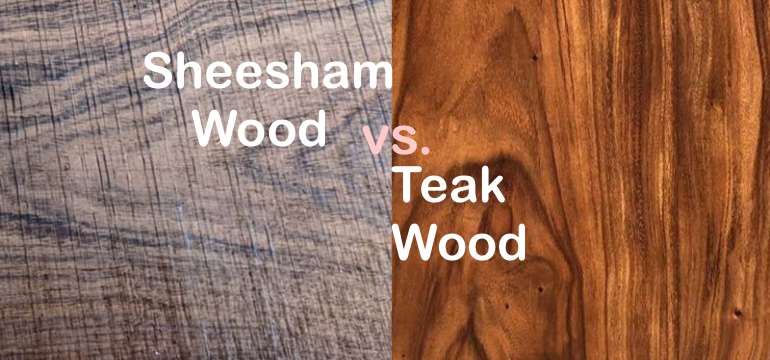
Many carpenters are already familiar with some of the more exotic species like teak. They want to know how sheesham wood stacks up against the long-time favorites like this species of hardwood. Much like the comparison of pros and cons with sheesham and mango wood, there is no clear winner between sheesham and teak.
Teak is well-known for its extremely tight grain and yellow-brown color, very similar to what you might find with sheesham but with less variation. The tight grain and natural oils found in teak make it resistant to rot, water, and fungus. If you are making outdoor furniture, this might be a great perk for you. It can definitely withstand more exposure to moisture than sheesham wood could take.
However, there are two major disadvantages to selecting teak for your project.
First, the wood is extremely dense and can be difficult to work with. It will be harder to make cuts or carve the wood because of its natural hardness. Brazilian teak wood (sometimes referred to as cumaru) is one of the hardest species of wood available with a Janka score of 3,300. On the other hand, sheesham wood is still a hardwood but is significantly softer and easier to work with.
Second, teak is going to be more expensive than sheesham. There is more scarcity for responsibly-harvested teak lumber, causing the price to rise far above that expected for sheesham wood. Because the two products are going to be extremely similar, it may make sense for you to choose the budget-friendly option for your next project.
Is Sheesham Wood Sustainable?
Finding properly sourced sheesham wood can be a bit tricky. Tracing the wood back to its original source is a relatively difficult process. The Forest Stewardship Council (FSC) is designed to help individuals make wise decisions about the sustainable production and harvesting of wood. They are an international non-profit organization that is simply dedicated to responsible forestry.
At the time of this article, there were no FSC-certified forests for the harvesting of sheesham wood. This does not mean that your sheesham wood was not necessarily responsibly harvested. Some manufacturers do everything in their power to ensure that these trees are coming from a sustainable source. However, there are no guarantees from major organizations that operate on a higher level.
It should be noted that the sheesham tree does grow extremely well and quickly. Many plantations invest a lot of resources into growing this tree and harvesting it responsibly. The sheesham tree can withstand poor soil conditions, lack of water, heavy rainfall, extreme cold snaps, and extreme heat. You would be hard-pressed to find another type of wood that could thrive under such varying circumstances.
If you want to purchase sheesham wood, make sure to ask questions about where the wood was sourced. A responsible retailer should be able to put your mind at ease about how the trees were cut down, where they were sourced, and whether any attempts to replant have been made.
Selecting Sheesham for Your Project
Planning your next project should be a great deal of fun, but you have to know all of the facts. Make sure that you are investing in the right species of wood from the very beginning so that your project will turn out perfectly. Many carpenters have already discovered the joy of working with sheesham wood. Could this wood species be the perfect fit for your next project? Give it a try this weekend and see what you think of this stunning species!
- How to Cut Lexan - September 25, 2020
- Mineral Spirits vs. Mineral Oil - September 25, 2020
- Shellac vs. Polyurethane - September 24, 2020
